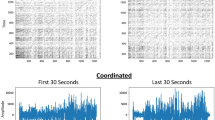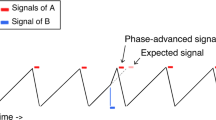Tumultuous applause can transform itself into waves of synchronized clapping.
Abstract
An audience expresses appreciation for a good performance by the strength and nature of its applause. The thunder of applause at the start often turns quite suddenly into synchronized clapping, and this synchronization can disappear and reappear several times during the applause. The phenomenon is a delightful expression of social self-organization that provides an example on a human scale of the synchronization processes that occur in numerous natural systems, ranging from flashing Asian fireflies to oscillating chemical reactions1,2,3. Here we explain the dynamics of this rhythmic applause.
Similar content being viewed by others
Main
We investigated the mechanism and development of synchronized clapping by making a series of measurements focusing on the collective aspects of the self-organization process as well as on the behaviour of the individuals in the audience. We recorded several theatre and opera performances in Romania and Hungary by using a microphone placed on the ceiling of the hall (Fig. 1a). Typically, after a few seconds of incoherent random clapping, a periodic signal developed (a sign of synchronized clapping), visible in Fig. 1a as pronounced spikes. The transition is also captured by the order parameter (Fig. 1c), which increases as the periodic signal develops, and decreases as it disappears.
a, Global noise intensity (Ig) as a function of time. The digitized data were squared and the moving average was determined over a window of size 0.2 s, several times shorter than the clapping period. A characteristic region indicates the appearance and disappearance of the synchronized clapping. Over several performances, we recorded 50 similar sequences of synchronized clapping (for additional data sets and audio recordings, see http://www.nd.edu/~networks/clap). b, Local noise intensity ( Il), measured by a hidden microphone in the vicinity of a spectator. c, Order parameter, r, defined as the maximum of the normalized correlation between the signal c(t) and a harmonic function, r = [max(t,φ)∫t+Tt−T c(t) sin(2π/ T+φ)dt]/[∫t+Tt−T c(t)dt ], where φ and T span all possible values. d, Average noise intensity, obtained by taking a moving average over a 3-s window of the global noise intensity shown in a. e, The clapping period, T, defined as the intervals between the clearly distinguishable maxima. f, The normalized histogram of clapping frequencies measured for 73 high-school students (isolated from each other) for mode I (black) and mode II (red) clapping. g, Normalized histogram for mode I and II clapping obtained for a single student, sampled 100 times over a one-week period.
Although synchronization increases the strength of the signal at the moment of the clapping, it leads to a decrease in the average noise intensity in the room (Fig. 1d). This is surprising, as the driving force for synchronization would be expected to reflect the desire of the audience to express its enthusiasm by increasing the average noise intensity.
The origin of this conflict between the average noise and synchronization can be understood by correlating the global signal with the behaviour of an individual in the audience. We demonstrated this by recording the local sound intensity in the vicinity of a group of oblivious individuals ( Fig. 1b). In the incoherent phase, the local signal was periodic, with a short period corresponding to the fast clapping of an individual in the audience. However, the clapping period suddenly doubled at the start of the synchronized phase (at about 12 seconds in Fig. 1a,b), and slowly decreased as synchronization was lost (Fig. 1e).
The decrease in the average noise intensity is therefore a consequence of the period doubling, because there is less clapping per unit time. An increase in the average noise intensity is possible only by decreasing the clapping period, which can indeed occur (Fig. 1e). However, the decreasing clapping period gradually brings the synchronized clapping back to the fast clapping heard in the early asynchronous phase, and synchronization disappears. Apparently, this conflicting desire of the audience simultaneously to increase the average noise intensity and to maintain synchronization leads to the sequence of appearing and disappearing synchronized regimes.
These results indicate that the transition from random to synchronized clapping is accompanied by a period-doubling process. To determine whether period doubling is in fact a necessary condition for synchronization, we investigated the internal frequency of clapping by several individuals in controlled clapping experiments. Individual students, isolated in a room, were instructed to clap as they would immediately after a good performance (mode I clapping) or during the rhythmic applause (mode II clapping).
The frequencies of the two modes of clapping are clearly separated and the average period doubles from mode I to mode II clapping ( Fig. 1f). Most important, however, is that the width of the frequency distribution and the relative dispersion of mode II clapping is considerably smaller, a result that is reproducible for a single individual as well (Fig. 1g).
Our results indicate that after an initial asynchronous phase, characterized by high-frequency clapping (mode I), individuals synchronize by eliminating every second beat, suddenly shifting to a clapping mode with a double period (mode II) where dispersion is smaller. For a group of globally coupled oscillators, the condition for synchronization is that dispersion must be smaller than a critical value4,5. Consequently, period doubling emerges as a condition for synchronization, because it leads to slower clapping modes during which significantly smaller dispersion can be maintained.
Our measurements offer an insight into the mechanism of synchronized clapping: during fast clapping, synchronization is not possible owing to the large dispersion in the clapping frequencies. After period doubling, as mode II clapping with small dispersion appears, synchronization can be and is achieved. However, as the audience gradually decreases the period to enhance the average noise intensity, it slips back to the fast clapping mode with larger dispersion, destroying synchronization.
In summary, the individuals in the audience have to be aware that by doubling their clapping period they can achieve synchronization. This perhaps explains why in the smaller and culturally more homogeneous eastern European communities, synchronized clapping is a daily event, whereas it happens only sporadically in western European and North American audiences. In general, our results offer evidence of a novel route to synchronization, not yet observed in physical or biological systems2,3,5,6.
References
Strogatz, S. H. & Stewart, I. Sci. Am. 102–109 (December, 1993).
Bottani, S. Phys. Rev. E 54, 2334–2350 (1997).
Glass, L. & Mackey, M. C. From Clocks to Chaos: The Rhythms of Life (Princeton Univ. Press, Princeton, NJ, 1988).
Winfree, A. T. J. Theor. Biol. 16, 15 (1967).
Kuramoto, Y. & Nishikava, I. J. Stat. Phys. 49, 569–605 (1987).
Mirollo, R. & Strogatz, S. H. SIAM J. Appl. Math. 50, 1645–1662 (1990).
Author information
Authors and Affiliations
Corresponding author
Rights and permissions
About this article
Cite this article
Néda, Z., Ravasz, E., Brechet, Y. et al. The sound of many hands clapping. Nature 403, 849–850 (2000). https://doi.org/10.1038/35002660
Issue Date:
DOI: https://doi.org/10.1038/35002660
This article is cited by
-
Moving in synchrony with an avatar – presenting a novel and unbiased body sway synchronization paradigm
Current Psychology (2023)
-
Clap, Clap, Clap - Unsystematic Review Essay on Clapping and Applause
Integrative Psychological and Behavioral Science (2023)
-
Classical colored noise-induced quantum synchronization
Quantum Information Processing (2023)
-
A Nonlinear Dynamic Approach of the Notion of Interaction
Integrative Psychological and Behavioral Science (2023)
-
Coordination dynamics of multi-agent interaction in a musical ensemble
Scientific Reports (2022)
Comments
By submitting a comment you agree to abide by our Terms and Community Guidelines. If you find something abusive or that does not comply with our terms or guidelines please flag it as inappropriate.




